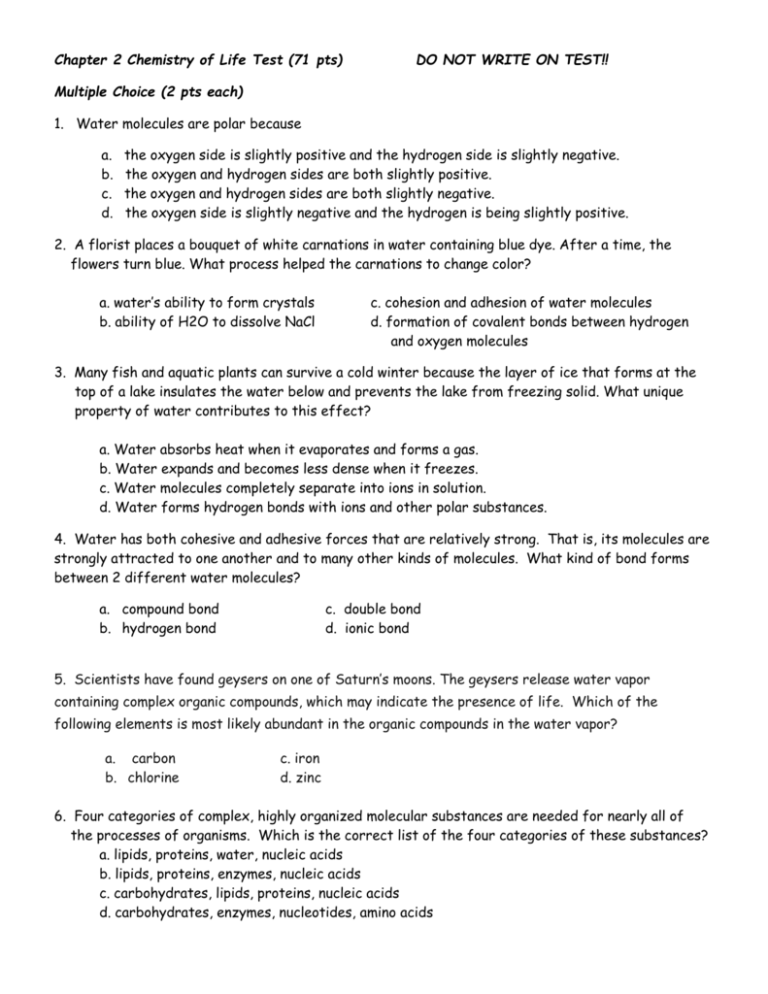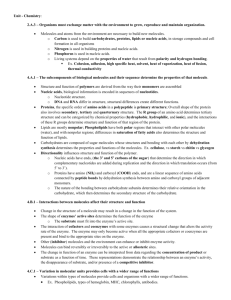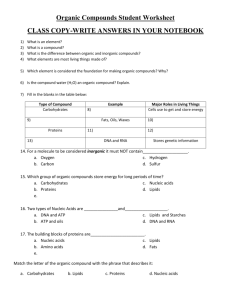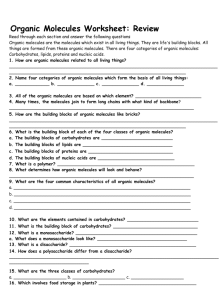Ch2 Test for Retake Preparation 10-2-13
advertisement

Chapter 2 Chemistry of Life Test (71 pts) DO NOT WRITE ON TEST!! Multiple Choice (2 pts each) 1. Water molecules are polar because a. b. c. d. the oxygen side is slightly positive and the hydrogen side is slightly negative. the oxygen and hydrogen sides are both slightly positive. the oxygen and hydrogen sides are both slightly negative. the oxygen side is slightly negative and the hydrogen is being slightly positive. 2. A florist places a bouquet of white carnations in water containing blue dye. After a time, the flowers turn blue. What process helped the carnations to change color? a. water’s ability to form crystals b. ability of H2O to dissolve NaCl c. cohesion and adhesion of water molecules d. formation of covalent bonds between hydrogen and oxygen molecules 3. Many fish and aquatic plants can survive a cold winter because the layer of ice that forms at the top of a lake insulates the water below and prevents the lake from freezing solid. What unique property of water contributes to this effect? a. Water absorbs heat when it evaporates and forms a gas. b. Water expands and becomes less dense when it freezes. c. Water molecules completely separate into ions in solution. d. Water forms hydrogen bonds with ions and other polar substances. 4. Water has both cohesive and adhesive forces that are relatively strong. That is, its molecules are strongly attracted to one another and to many other kinds of molecules. What kind of bond forms between 2 different water molecules? a. compound bond b. hydrogen bond c. double bond d. ionic bond 5. Scientists have found geysers on one of Saturn’s moons. The geysers release water vapor containing complex organic compounds, which may indicate the presence of life. Which of the following elements is most likely abundant in the organic compounds in the water vapor? a. carbon b. chlorine c. iron d. zinc 6. Four categories of complex, highly organized molecular substances are needed for nearly all of the processes of organisms. Which is the correct list of the four categories of these substances? a. lipids, proteins, water, nucleic acids b. lipids, proteins, enzymes, nucleic acids c. carbohydrates, lipids, proteins, nucleic acids d. carbohydrates, enzymes, nucleotides, amino acids 7. The function of enzymes is to a. reduce the activation energy needed for reactions b. serve as building blocks for amino acids c. provide structural support to cells d. cause all reactions to occur 8. Many aquatic birds secrete waxy organic substances that repel water. The birds use these substances to coat their feathers. An analysis of these substances would reveal that they are composed mostly of a. lipids b. proteins c. carbohydrates d. nucleic acids 9. RNA and DNA are which type of organic compound? a. carbohydrate c. nucleic acid b. lipid d. protein 10. A scientist observes that, when the pH of the environment surrounding an enzyme is changed, the rate the enzyme catalyzes a reaction greatly decreases. Which statement best describes how a change in pH can affect an enzyme? a. b. c. d. a pH change can cause the enzyme to change its shape. a pH change can remove energy necessary to activate an enzyme. a pH change can add new molecules to the structure of the enzyme. a pH change can cause an enzyme to react with a different substrate 11. Like complex carbohydrates, proteins are biomolecules that serve many functions and can be chemically broken down and restructured. Both proteins and complex carbohydrates are which of the following? a. Polymers of smaller subunits c. Lipids of large molecules b. Sequences of sugars d. Nucleotides of DNA 12. When an animal has to survive without food for a long time, it will eventually break down proteins for energy. However, this process occurs only after exhausting the animal’s reserves of a. DNA and RNA. c. carbon dioxide and water. b. carbohydrates and lipids. d. enzymes and nucleic acids 13. The graph shows how the activity of an enzyme changes at different temperatures. Which statement BEST describes what happens to the enzyme when the temperature of the reaction increases to 63 degrees? a. b. c. d. The enzyme is used up and the reaction stops. The enzyme begins to decrease the rate of the reaction. The enzyme continues to increase the rate of the reaction. The enzyme changes shape and can no longer speed up the reaction. 14. A student filled two Petri dishes with a clear cornstarch gel, then marked the letter “X” invisibly onto the gel in Petri dish 1 with a damp cotton swab. He then placed saliva from his mouth onto a second cotton swab and used that swab to mark the letter “X” invisibly onto the gel in Petri dish 2. Fifteen minutes later, he rinsed both Petri dishes with a dilute solution of iodine to indicate the presence of starch. The surface of Petri dish 1 turned completely blue, indicating starch. Most of the surface of Petri dish 2 was blue, except the letter “X” was clear, as shown above. The most probable explanation of the clear “X” is that a. b. c. d. the starch in the gel was absorbed by the damp cotton swab. the iodine reacted with a chemical in the saliva and broke down. a chemical in the saliva broke down the starch in the gel. the saliva prevented the iodine from contacting the starch in the gel. 15. Chemistry is important in the study of living things because….. (2 pts) 16. Explain the difference between organic and inorganic compounds. Give an example of each. (4 pts) 17. Compare and contrast cohesion and adhesion using capillary action to illustrate your comparison. (4pts) 18. Name the 6 elements most commonly found in living things. Circle the element found in ALL living things. (7 pts) 19. Describe one factor that can increase enzyme activity and one factor that can decrease enzyme activity. Explain why each factor described has this effect. (4 pts) 20. Choose a station from Wonderful Water Lab (magic jar, string thing or balloon magic). Sketch what happened at eye view and microscopic view. Explain your sketches. (8 pts) 21. Fill in the following table: (4 pts) Type of Organic Compound A. Monomers amino acids B. glycerol and fatty acids C. monosaccharides D. nucleic acids 22. Fill in the following table: (4 pts) Type of Organic Compound A. Function of Polymer membranes; long-term energy storage B. structure, enzymes, immune system C. store genetic code; transfer genetic code D. structure; short-term energy storage 23. Students recorded the observations below for the monosaccharide test in the Identifying Organic Compounds lab. Substance egg white honey butter distilled water dextrose solution Negative (0) blue Benedict’s Test 0 +++ 0 + ++++ Color blue orange blue blue-green brick-red Positive (+) blue-green; (++) green; (+++) yellow; (++++) brick red a. According to the data collected, monosaccharides were present in which substance(s)?(2 pts) b. Distilled water is included as a control for all the tests for organic compounds. Explain why water is a good control for these tests? (2 pts) c. Explain why the results in the data table for water are not what might be expected. What might have occurred during the lab that would account for this result? (2 pts)








